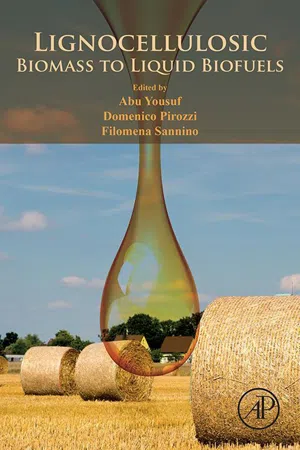
- 358 pages
- English
- ePUB (mobile friendly)
- Available on iOS & Android
Lignocellulosic Biomass to Liquid Biofuels
About This Book
Lignocellulosic Biomass to Liquid Biofuels explores the existing technologies and most recent developments for the production of second generation liquid biofuels, providing an introduction to lignocellulosic biomass and the processes for its conversion into biofuels. The book demonstrates biorefinery concepts compared with petro refinery, as well as the challenges of second generation biofuels processing. In addition to current pre-treatment techniques and their technical, environmental and economic implications, chapters included also further examine the particularities of conversion processes for bioethanol, biobutanol and biodiesel through chemical, biochemical and combined approaches. Finally, the book looks into concepts and tools for techno-economic and environmental analysis, which include supply chain assessment, by-products, zero-waste techniques and process evaluation and optimization.
Lignocellulosic Biomass to Liquid Biofuels is particularly useful for researchers in the field of liquid biofuels seeking alternative chemical and biochemical pathways or those interested advanced methods to calculate maximum yield for each process and methods to simulate the implications and costs of scaling up. Furthermore, with the introduction provided by this volume, researchers and graduate students entering the field will be able to quickly get up to speed and identify knowledge gaps in existing and upcoming technology the book's comprehensive overview.
- Examines the state-of-the-art technology for liquid biofuels production from lignocellulosic biomass
- Provides a comprehensive overview of the existing chemical and biochemical processes for second generation biofuel conversion
- Presents tools for the techno-economic and environmental analysis of technologies, as well as for the scale-up simulation of conversion processes
Frequently asked questions
Information
Fundamentals of lignocellulosic biomass
Abstract
Keywords
1.1 Introduction
Table of contents
- Cover image
- Title page
- Table of Contents
- Copyright
- Dedicated
- List of contributors
- About the editors
- Preface
- Acknowledgments
- Chapter 1. Fundamentals of lignocellulosic biomass
- Chapter 2. Pretreatment of lignocellulosic biomass for efficient enzymatic saccharification of cellulose
- Chapter 3. Bioconversion of lignocellulosic biomass to bioethanol and biobutanol
- Chapter 4. Lignocellulosic biomass to biodiesel
- Chapter 5. Biobutanol from lignocellulosic biomass: bioprocess strategies
- Chapter 6. Syngas fermentation to bioethanol
- Chapter 7. Fischer–Tropsch synthesis of syngas to liquid hydrocarbons
- Chapter 8. Constraints, impacts and benefits of lignocellulose conversion pathways to liquid biofuels and biochemicals
- Chapter 9. Environmental and socioeconomic impact assessment of biofuels from lignocellulosic biomass
- Chapter 10. Pretreatment of lignocellulosic sugarcane leaves and tops for bioethanol production
- Index